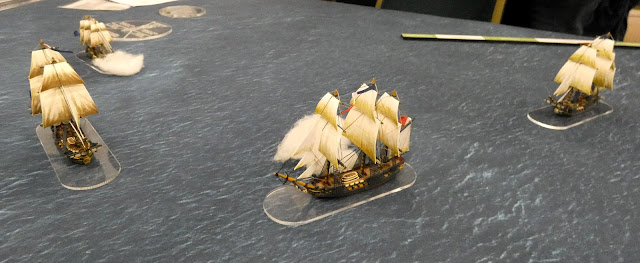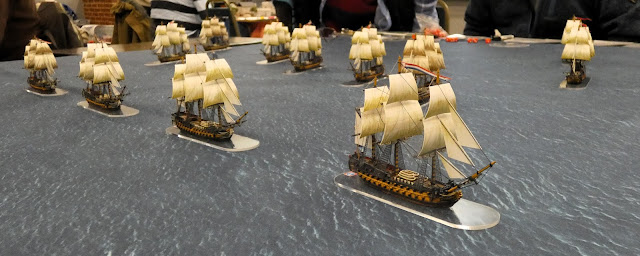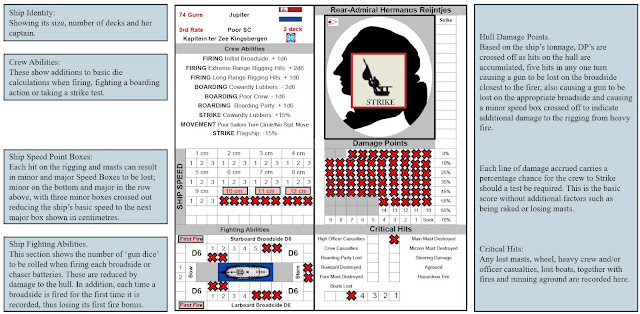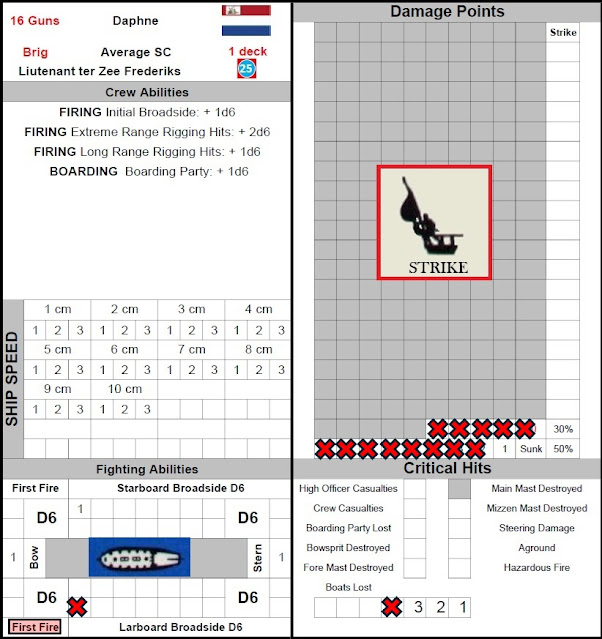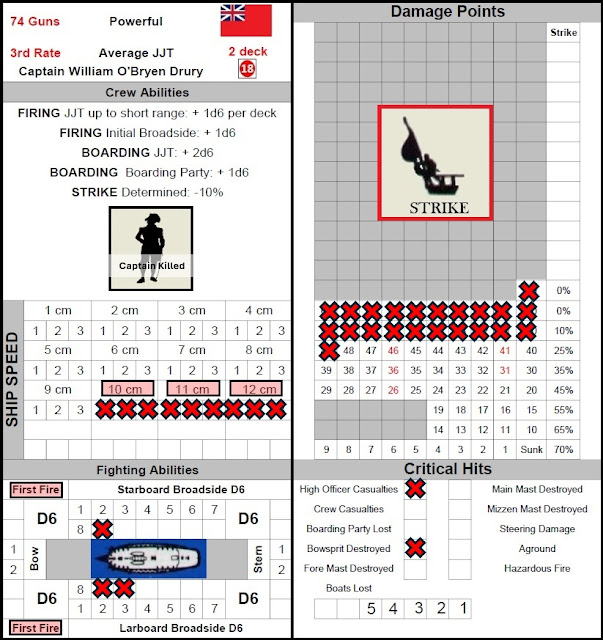 |
| HMS Lowestoffe - Derek Gardner |
Kiss Me, Hardy (KMH) made a return to the table at club this month following the completion of my Camperdown collection in October and a warm-up game with it back in March when we recreated part of the battle and the attack by Rear-admiral Onslow's Leeward Division on the rear of the Batavian-Dutch line, link to that post below
 |
| The plan and panorama brought to life on the table as the battle commences. Devon Wargames Group - Camperdown, Attack of the Leeward Division |
This time we were playtesting Scenario 21, one of a hundred single-ship, small squadron engagements I have been compiling, with this one taking the players back to the summer of 1795 in the Mediterranean as the British and Revolutionary French navies struggled for supremacy in the Eastern Mediterranean as the latter attempted to frustrate French naval support to their land forces operating against British allies, the Austrians.
William James in his Naval History of Great Britain Vol I picks up the account of this specific action that took place between the two fleets operating bases of Port Mahon in Minorca for the British and Toulon for the French.
In the month of June Admiral Hotham, while cruising with the British fleet off the Island of Minorca, received intelligence that the French fleet was at sea. To ascertain the fact, the admiral, on the evening of the 23rd, detached the 28-gun frigate Dido, Captain George Henry Towry, and 12-pounder 32-gun frigate Lowestoffe, Captain Robert Gambier Middleton, to reconnoitre the road of Toulon.
On the 24th, at 4 a.m., latitude 41° 8' north, longitude 5° 30' east, these frigates, standing close hauled on the larboard tack, with the wind at north-north-west, descried approaching them, nearly ahead, the French 40-gun frigate Minerve, Captain Perrée, and 36-gun frigate Artémise, Captain Charbonnier, which frigates, by a singular coincidence, had been ordered by the French admiral to proceed off Minorca, and ascertain the truth of a rumour that the British fleet was at sea.
The action on the 24th June 1795, would see the Minerve and the Artémise engage the frigates HMS Dido and HMS Lowestoffe, resulting in the Minerve surrendering to the British, and her consort Artémise escaping having fled, with the former later commissioned into the Royal Navy as HMS Minerve.
The set up for this little fight is recounted in James' history, and the scenario picks up from where the two French ships who had originally run from the encounter, hauled up to await their pursuers, seemingly having observed their inferiority to themselves and confident of a positive outcome in their favour.
 |
| Captain Perrée and the 40-gun Minerve leads her consort Artémise with the British seen on the starboard bow. |
Thus the British have the wind gauge with both forces on a course to intercept one another and bring on the fight.
 |
| Likewise the British are set up in line ahead and at quarters |
For these smaller fights I prefer to use the order cards for each model as well as the standard chit draw mechanism in KMH, that requires individual commanders and their respective models to have course orders issued prior to the activation chits being drawn.
 |
| The KMH system of issuing an order for the model to travel straight, turn to starboard or larboard or tack, with a face down card only being revealed when a model is activated to move. |
This simple system of issuing an order for the model with a face down card directing it to travel straight, turn to starboard or larboard or tack, commits the player to that move without knowing what the opposition has ordered, coupled with the move sequence governed by the chit draw adding yet more uncertainty.
Thus the players find themselves forced to anticipate what an enemy commander will do in the next turn, not knowing who will move first, who will fire first or indeed how far a vessel will travel in a given turn, but instead only having a vague idea of the possibilities to work with, very much like their historical counterparts would have had to contend with during a real sea fight.
With the players briefed on the historical setup but not the outcome, the two squadrons contented themselves to spending the first couple of moves moving in line ahead, with the lead ship dictating the course and her consort simply following and maintaining station.
 |
| The next turn and Minerve has managed to cross the 'T', now engaging the Dido with a medium-range broadside to her hull and getting a similar salute from Dido's bowchasers. |
However on turn three the lead British frigate Dido signalled Lowestoffe to act independently and course orders were issued by the respective players with no coordination permitted between them until they reformed. This happened to correspond with the Lowestoffe coming into the arc of fire from Minerve at extreme range and the Frenchman opted to open a broadside against the enemy frigates rigging, bringing down several spars in the process, prompting return fire from the British bow chasers that missed.
 |
| The British have still to move as indicated by their orders cards face down by the models |
In the next turn, about twenty minutes into the action, the Minerve managed to cross the bows of the Dido, at medium range this time opting to put round shot in the enemy's hull, again prompting a response from the enemy bow chasers and suffering slight damage in return, with the French opting to stay in line ahead as the British approached bow on.
With Dido now within range to pass between the two French frigates the next turn would be critical as to who got the drop on the other, namely would the Minerve open fire again before the Dido had moved and then move away from a possible stern rake or would the Dido do just that by placing her broadsides against both French frigates in the gap that loomed ahead?
 |
| Captain Towry takes full advantage of the fortunes of war to stern rake Minerve at short range |
Britannia would not be denied and Captain Towry took full advantage of the opportunity as his 'move' chit came out before that of the Minerve to reveal his orders to move straight ahead, soon followed by his 'fire' chit which found the British frigate squarely across the Minerve's stern gallery in a perfect position for a stern rake duly delivered at short range, leaving the French man on a strike test to go with the damage done to his hull.
 |
| Artémise fires of her starboard battery of guns against the fast approaching Lowestoffe causing a small fire to go with the damage inflicted. |
Meanwhile the Artémise following in her wake made a ineffectual attempt to support Minerve by firing her bow chasers against the Dido, but made much better use of her starboard battery of guns as she loosed off a medium range barrage against the fast approaching Lowestoffe that caused a small fire on board the British frigate.
The game was producing swings of fortune in each turn as each side strove to get into a commanding position and pull the fight in their direction, with the larger French ships relying on their greater size and ability to soak up punishment to outweigh the better fighting attributes but less sturdy British opponents.
The next turn, with our battle closing in on an hour of hard fighting, provided the first indication of who would get command of the situation as the Minerve looking to continue the fight but required to check her morale after being stern raked by HMS Dido faced a 'strike test' chit early in the move.
The damage had been chastening but not overwhelming and the Minerve with her large crew and hull still had a positive morale rating of 75%, meaning any die score at or below that number would keep her in the fight, that was until the dice settled at the bottom of the tower to reveal a score of 77% and thus she hauled down her colours to await a British boarding party.
 |
| Captain Charbonnier and the Artémise are assailed from both sides as the Minerve having struck drifts close by impotently. |
Captain Charbonnier aboard Artémise was stunned to see his comrade haul down his colours and, making preparation to abandon the fight and attempt to flee the table, was assailed from two directions as the Dido grazed his starboard bow and fouled his ship, and the Lowestoffe, having extinguished her fire poured in a devastating broadside at point blank range on her larboard quarter knocking out her remaining larboard guns and bringing down her mainmast in the process.
The resulting boarding action initiated by Charbonnier seemed to be the right response as his crew narrowly won the first attempt to get over the bulwarks of the Dido and take the fight to the British, but in the next two rounds of combat they were driven back by the Dido's and on to their own lower deck as the Lowestoffe kept up a remorseless barrage on her defenceless larboard side in support of the melee that had its inevitable result as the Artémise hauled down her colours with her morale rating reduced to a mere 25% of its original rating.
 |
| My two new Turner Miniatures 3D printed French 40-gun frigates Virginie (right) and Coquille (left). JJ's Wargames - French 40-gun Frigate Virginie JJ's Wargames - French 40-gun Frigate La Coquille The next time I run this scenario I aim to do it with more appropriate models. |
This scenario produced the game I had hoped for with two evenly matched sides pitching the larger or equal French frigates against two similar or smaller but better quality opponents and giving me the opportunity to run out my two new Turner Miniatures 3D printed French 40-gun frigates Virginie and Coquille for the first time, but sadly with the Coquille and my two British imposters, as I am still to build my new 32 and 28 gun British opponents and a French 32 in post 1794 colours which are in the shipyard as I type.
All the models are kitted out with Warlord Games, Black Seas boats, masts, sails and in some cases figureheads.
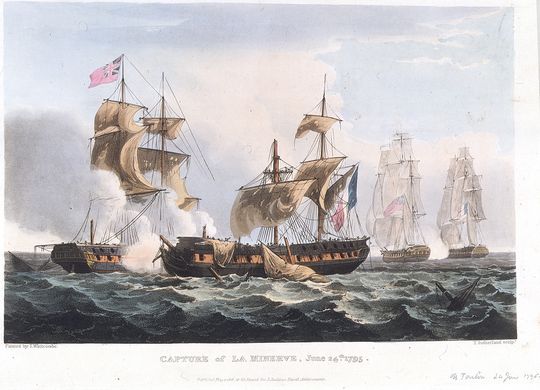 |
| Capture of La Minerve by Thomas Whitcombe |
Thanks to Ian, Gavin and Paul for producing a very entertaining and well played game, with bags of drama and laughs, and with Gavin and Paul new to the club and to Kiss Me, Hardy.
JJ






